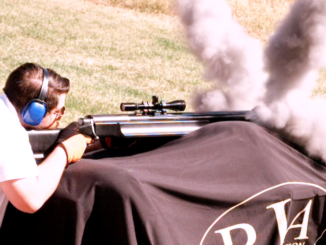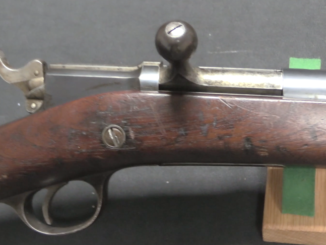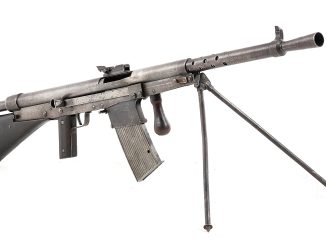The story of the development of the Barrett M82 .50 BMG semiauto rifle is really a neat story – much more interesting than most people probably expect, and reminiscent of many firearms development stories of the 1800s. Ronnie Barrett was working as a photographer in the late 70s, and became interested (perhaps obsessed?) with the idea of a semiauto .50 caliber rifle after a photo session with a Vietnam War jungle patrol boat (which was armed with a pair of M2 .50 caliber machine guns). At the time, the only civilian options for the .50 BMG cartridge were conversions of WWII antitank rifles like the Boys and PTRD.
Barrett, with basically no formal engineering background, sketched up a design and approached some machine shops for advice and assistance. He started working in his garage, and after a couple years had a function prototype completed. He sold the rifles commercially at gun shows and through publications like Shotgun News until making his first military sale in 1989, to the Swedish government. The following year he received an order from the US military, and sales took off from there.
Contrary to common expectation, the Barrett M82A1 is not really a “sniper” rifle – as a semiautomatic design with a recoil-operated action it’s potential accuracy is much less than that of a bolt action precision rifle – and this is amplified by the lack of a precision .50 BMG cartridge in US military service. In practice, the M82A1 will shoot about 3 MOA with normal ball ammunition, and about 1.5-2 MOA with good handloads. It is used primarily as an EOD rifle to detonate heavy-walled unexploded shells at a safe distance, and as an anti-material rifle to attack light vehicles and infrastructure at a long distance. These are relatively large targets, which require the large payload of a .50 BMG projectile but not the extreme accuracy of a true “sniper’s” rifle.




I think at least one idiot thought the furniture would protect him from the M82. If the projectile fragments after penetrating a brick wall, anyone behind the wall near the new hole will be partially reduced to hamburger!
“anti-material rifle to attack light vehicles and infrastructure at a long distance. These are relatively large targets, which require the large payload of a .50 BMG projectile but not the extreme accuracy of a true “sniper’s” rifle.”
Does anyone tried to neck-up .50 BMG cartridge to put more HE into bullet?
I know about 16×98 Vega cartridge: http://www.municion.org/16/16x98Vega.htm
but maybe were there other attempts?
I don’t know about .50 BMG variants, but there is the South African Mechem (Denel) NTW-20, which fires the 20×82mm cartridge of the MG 151/20. The idea is that the recoil of the relatively low velocity (720 m/s) is much more manageable than the WW2 anti-tank rifles, which fired higher velocity cartridges (well, not the S18-100 firing the 20×105 “Short Solothurn”, but it had a considerably heavier projectile).
Today the NTW-20 is offered also in 20×110mm Hispano, which is a much hotter cartridge at 820 m/s. While still somewhat milder than 20×138 “Long Solothurn”, it must be a real kicker…
For US version of the same idea the 20×102 fired by the M61 rotary aircraft cannon would be a fairly good choice, since while it has a high muzzle velocity (1030 m/s), the projectiles are relatively light compared to other modern or even WW2 20mm cartridges, and there is a good selection already available.
Someone has done the opposite of necking up a .50bmg and has necked a 20mm down to .50 to make a 20/.50 round. For some reason.
How about 20x99R Shvak, when we are that far:
http://www.quarryhs.co.uk/ammotable2.html
…it is super for extraction.
It would require some clever recoil mechanism though; like one part of breech flies back and the other forward.
“20x99R Shvak”
Which is derived from earlier 12,7x108R (not to be confused with 12,7×108):
http://www.municion.org/12_7/12_7x108R.htm
it was used in ShVAK (machine gun)
I think its rim is rather drawback, especially if you want magazine weapon.
About necked-up .50 BMG: there were several such cartridges used in the 1930s and WW2, but they are all long obsolete and out of production. The various 13.2mm HMG cartridges and the .55 Boys were probably the most common ones.
I saw this and immediately remembered the .700 WTF
https://www.youtube.com/watch?v=vo4ahgn_j0E
there you go.
And to ‘aa’ I will add they are specifically outlawed in Canada as well, despite not having a destructive devise category and other 50 bmg’s being legal.
I’ve often thought that a good round to play with would be to turn down a 14.5×114mm to 12.7×114mm. This would allow the usage of the .50 bullet in the higher powder capacity of the 14.5 case. I’ve heard of people that neck-up a round, but is it possible to neck-down a round. Since .50 is the max limit size wise, would it still be legal and not count as a AOW issue?
Necking down is less common, but still done fairly often. For example the .357 Sig is basically a necked-down 10mm Auto, although the case was also shortened slightly. There are also the .32 NAA (necked-down .380 ACP), .25 NAA (necked-down .32 ACP) and too many other examples to be listed here.
Somewhere in the compost heap of useless and often inaccurate information I have for a brain, I seem to recall that at least a few M82s made it to Beruit (in the hands of Lebanese Americans who went home for the war) way before 1989, where their performance in the battles between highrise hotels showed their worth. No idea if that is true or not, but if anyone knows it would be someone here.
Daweo – since US law prohibits rifled weapons over .50 caliber (not to mention explosive-filled projectiles) if there has been any experimentation with over-.50 wildcats it has been military. I know Barrett was playing with a semi-auto 25-mm long-range grenade-launcher sort of thing, but abandoned the project after it broke more shoulders than the 7-barrel Nock gun of Royal Navy fame. Speaking of repro firearms that Ian should shoot for our viewing pleasure…..
I believe you meant this:
http://milpas.cc/rifles/ZFiles/Anti%20tank/Barrett%20XM-109/Small%20Arms%20Review%20Article.pdf
Kind of modern day Panzerbuchse.
I recently subscribed to Forgotten Weapons and am quite pleased with the distributed articles.
Have you considered publishing?
The cocking portion of the bolt is very much like that of the Browning 1917/1919 machine gun bolt.
Very good observation.
This must have been and probably still is an attractive option for given purpose – material degradation. But, facing sophisticated enemy (such as Nato is clamoring for lately) would likely have radar in place and at 1-2km range it is no big deal to discover shooter ahead of him to commence with fulfilling his task. Thus, all the effort may come to nothing. One would almost think that anti-tank type missile such as HEAT would be a better option.
Not to be quick with condemning this brilliant rifle into FW category however, it may still have some life to it.
Anti personnel radar hasn’t gotten that good, has it? Last time I checked tanks and cars were the smallest objects detectable by radar and people generally do not register on radar screens unless they’re covered in steel armor or overloaded with machine gun belts. I could be wrong, but usually one can figure out if radar is present if given countermeasures. Or one could try using decoys to draw attention elsewhere. Did I mess up this time?
But then, there is this: radar and thermal signature denial.
http://www.army-technology.com/contractors/camouflage/intermat/
It goes on and on….
Very true and therefore there is a constant arms race between detection devices and camouflage/stealth development.
I am not that versed with that technology but aware it exists. With US forces for sure and conceivably with its closest match. I cannot even imagine that someone would install a field depot for fuel, ammo and other supplies without dutifully protecting them with sensors.
Commercially available radar, such as used for boats and small ships, can detect a beer can sized object a couple of miles away under the right conditions. It all depends on what the ground around the object is – if it’s in the trees radar won’t help.
The problem with radar is that it tends to pick up a lot of stuff that isn’t useful and that has to be filtered out. Ground surveillance radar can certainly pick up soldiers with metal weapons and ammo walking in the open, but if the same guys have steep hill or rocks and boulders behind them, or especially if they are crawling and keeping the metal stuff close to the ground, reliable detection with radar becomes much more difficult.
Modern automated surveillance systems try to combine other information channels such as thermal imaging with radar and alert personnel of potential threat. And they do work, but countermeasures for them exist as well.
However, I don’t think the primary purpose of anti-materiel rifles is attacking enemy rear bases, which are often well guarded anyway. Vehicle convoys are a much more realistic target, or making life difficult for enemy vanguard as part of rear guard. It also pays to remember that many enemies of Western armies are not sophisticated state actors, but terrorist organizations like IS or their third world supporters like Taleban Afghanistan in 2001.
Ground surveillance radar has been around since the 1960’s. The US Army introduced it in the mid 60’s and trialled it in Vietnam and even then it was certainly good enough to detect individuals especially when carrying metal objects like weapons, magazines. Modern versions such as Blighter are much more impressive.
http://www.blighter.com/key-markets/defence.html
Technology had been there for some time, as the article says. It has to do with thermal image (infrared) processing.
As I keep reading on variety of things for couple of decades, I wonder – what’s the point of trying to overcome enemy, if means and capabilities are similar. They can as well shake hands and go home.
But then, this is technology ‘availability’ which does not exactly meant it is in service. I imagine, price tag will be phenomenal. So, do you want to build schools and hospitals or buy fancy tech? Simple question to answer, huh?
Mounting the accelerator on the back of the bolt and using it to force unlocking is a very clever idea.
It allows the receiver to be far simpler and lighter than would be the case if the receiver had to contain slideways and cams to lock and unlock the bolt.
having the accelerator on the back of the bolt gets it away from the complicated business of locking lugs and feeding
it also saves having a strong area in the receiver for the accelerator to pivot, all the the receiver has to do is to act on the easy end of the accelerator lever.
sorry Denny, I accidentally replied to you, instead of posting an independant new comment.
No problem Keith; your note of accelerator is worthwhile though. I have too many entries; have to stop for now.
Not to bad for control either; Jerry Miculek is doing from hip:
https://www.youtube.com/watch?v=pAW3dlTMv6g
THE BARRET .50BMG M82A1. NOT THE ONLY .50 SNIPPING RIFLE IN THE WORLD . BUT ONE OF THE BEST.
Homer Koon’s Omega III bolt action rifle used the idea of a square, instead of a triangle, in order to form 4 tiny little triangular locking lugs.
It actually gives quite limited bearing area per lug, and is of questionable engineering value.
At 17:55 in the video:
“I hope you enjoyed the video. I hope I didn’t make too many people sad”
At that point, I knew what had to be coming next — the fact that .50 BMG guns are specifically outlawed in the most populous state in the nation, California. Or maybe the fact that Connecticut outlaws the Barrett M82A1 specifically (but ironically not other .50 BMG rifles) The list goes on and on … if you live in the USA, there’s a good chance that you can’t legally own this gun — and unlike most so-called “assault weapon” bans, there is simply no way to legalize a .50 BMG.
(But alas, I was wrong –false alarm– the “making people sad” line was about another subject entirely.)
Then at 18:18 in the video:
“If you’d like to own one of these things, yourself of course, they are not NFA regulated. They are available to anyone who can own a regular firearm, and if you think that needs to be you … you can place a bid ..”
While the .50 BMG is not (yet) regulated under US Federal law, it’s hard to hide from the fact that it’s outlawed/restricted in a large chunk of the country, and with a growing movement to eradicate these guns completely from civilian ownership, both on a state-by-state basis as well as by federal law.
On the Rock Island Auction page, there does not appear to be any “fine print” about the unique legal restrictions of this rifle, or even the usual “consult an attorney / observe all federal, state, and local laws /etc.” boilerplate.
Perhaps this legislation issue stems from the fact that any crime committed with a heavy machine gun round would be treated as either insanity or terrorism in which case the National Guard should be called in and respond by reducing the perp to hamburger with artillery shells and jalapeños on top!! Also the M82 is just too heavy to use in any store robbery or mugging incident. Besides, how would one hide the rifle once nosy cops with lethal shock sticks and FN Five-seveNs loaded with armor penetrating ammo showed up? I don’t suppose you intend to exterminate the police force, right?
Funny (or is it silly 😉 ) store robbery scenarions aside, does any US police department actually issue the FN Five-Seven?
I believe the Secret Service uses them…
I suppose because of the armor piercing capability?
“(…).50 BMG guns are specifically outlawed(…)”
Wait, can be this or that cartridge outlawed? If yes was 12.7×108 outlawed in any state?
“there is simply no way to legalize a .50 BMG”
Is changing caliber to .416 solution: https://en.wikipedia.org/wiki/.416_Barrett ?
I was thinking of the way that the main difference between an illegal “assault weapon” and a legal sporting rifle are largely cosmetic features, such as having a pistol grip instead of a thumbhole stock, or a flash suppressor instead of a muzzle brake. The .50 BMG, however, is in a class all by itself, as the ‘evil features’ that make other guns illegal don’t make any difference with the 50 BMG.
It’s interesting that all the US states and districts that banned/restricted the .50 BMG did not ban any other similar 50 caliber cartridge guns, such as the Soviet 12.7x108mm or the French .510 DTC.
New Jersey came close to banning all 50 caliber guns a few years ago, including presumably flintlock muskets. The final bill, vetoed by Governor Chris Christie, who was the very person who asked for the law in the first place. So the Barrett M82A1 remains legal in anti-gun New Jersey — but for how much longer is anyone’s guess.
Another interesting trait about gun laws in the United States is that they tend to be written by people who know extremely little about firearms. In the case of California’s recent bullet-button ban, it was hilarous the way manufacturers already had a workaround ready for sale the day that bill (along with multiple others) was signed into law — making a mockery of California’s anti-2nd-amendment government.
Gun law affect weapon development not only in USA. For example in Kanton Graubünden (part of Switzerland) is only one legal cartridge for hunting – namely 10,3 x 60 R:
https://rws-munition.de/rws-jagd-bereich/rws-jagdmunition/rws-buechsenpatronen-fuer-den-jaeger.html#!0/0/5
I will not be surprised if readers not interested in European hunting cartridge don’t know it. In fact it is Swiss designation for .450/.400 N.E. 2 3/8″ which itself is dimension-wise earlier .450/.400 Express 2 3/8″ dating back to 1881. I guess if not that it would fall in oblivion long long time ago.
Photos and images of 10,3 x 60 R cartridge:
http://lutzmoeller.net/1/10,3-mm/1032.php
Thanks Daweo. One of the things I’d like to learn more about would be the European (non-British) sporting guns, since they are rarely written about (at least in English) as well as rarely seen in America.
Interesting rifle of overcomlicated hundred and plus parts. Each main section seeming as designed by a separate person of different mantality and containing approaches as remedies for other section’s shortfall. Whole manuals of relating models interestingly named the “Recoil Spring” as “Main Spring”. It seems needing of correction of this firearm term by an overrule.
Ronnie G. Barett’s related patent; 4677897. Text includes also a hammer fired construction.
A further patent with SN. 4867040, describes nearly all features of this 82 Model and adds the “Accelerator” enabling slowed down separation of breechbolt and barrel for more positive extraction.
I believe that Ian’s references to Ronnie Barett’s experiences as a photographer during the Vietnam War, and to the so-called “jungle patrol boats”, actually pertain to the RAG’s, or River Assault Groups, otherwise commonly referred to nowadays in historical publications as the “Brown Water Navy”. The twin .50 Browning HMG mount was a salient feature on many of the RAG shallow-draft riverine gunboats.
Apparently the British Army’s SAS is operating under the mistaken impression that their Barretts are sniper rifles. In a very colorful event with a happy ending an SAS shooter killed several ISIS nitwits who were preparing to execute some hostages with a flamethrower. It was claimed to be a 1500 meter shot. See the link for a 9/11/16 article on this event published in the Daily Mail.
http://www.dailymail.co.uk/news/article-3783943/SAS-sniper-kills-ISIS-executioner-moments-kills-12-hostages.html
And the rifles of Robert Pauzer are forgotten.
.50BMG, gas operated, semi-auto.
Houston, Texas